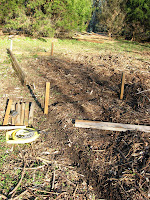
Friday afternoon I added more sugar syrup to the hives. The jar was empty and the other three hives needed syrup - their baggie were empty.

 Severe drought - 15 counties
Severe drought - 15 counties

From "The Salt Lake Tribune" 2/11/09
State and local officials have been anticipating the bees' arrival since they showed up in Mesquite, Nevada in 1999, just a few miles from the Utah line.
Although Africanized bees look like European honey bees, they tend to get irritated faster, respond with more firepower and stay mad longer than other bees. Their stings aren't more powerful but they're just more aggressive.
The bees are the result of interbreeding between European honey bees and bees from Africa. They were "inadvertently released" in Brazil in the 1950s. They were first spotted in Texas in 1990 and have since been found in several other states, including California, Florida, Arizona and Nevada.
They are widely feared by the public but since their introduction to the US in 1990, only 14 deaths have been reported over a period of several years, which makes them less hazardous than venomous snakes.
So far, we don't have any reports of Africanized bees in North Carolina.



 Look for the new message this year "Recipe 4 Love"
Look for the new message this year "Recipe 4 Love"


But if the bees were feral, Ubaldo Diaz (who is responsible for removing feral bee colonies in Palm Bay) stated even if her neighbors complained about their presence, he could not remove them without her consent.
So in the City's eyes, she would be well within her rights to keep a feral bee colony on her property, but her well-managed, unaggressive domesticated bees are deemed a nuisance.
One of the council members (the only dissenting vote) is hoping to introduce new legislation that would allow Michelle and other city residents to keep honeybees on their properties.

3/18/08
30,000 bees saved from an ancient oak at Wake Med Hospital's long term care facility in Fuquay Varina

Last Saturday our quilting bee did a Cutting Bee based on a Fons & Porter swap in their May/June 2000 Love of Quilting magazine. Everyone brought 1/2 yard cuts of yellow, blue and green - 3 of each color - each 1/2 yard was cut into two 4-1/2" strips and three 2-1/2" strips.
Then the fabric strips were put in color groups and we went around the table and picked up one strip from each group - around and around and around! It was great fun and I got fabrics I would never have bought and some "new" stash. No cost fabric shopping!

Durham City Council members want more time before deciding . . . . to be continued.
I don't think my opinion should be made public.

